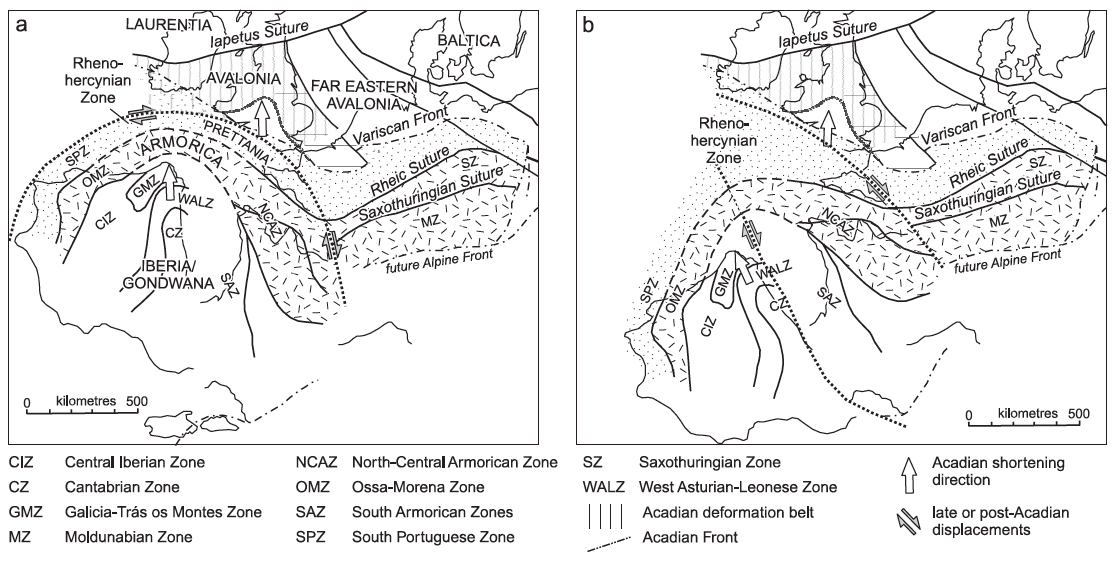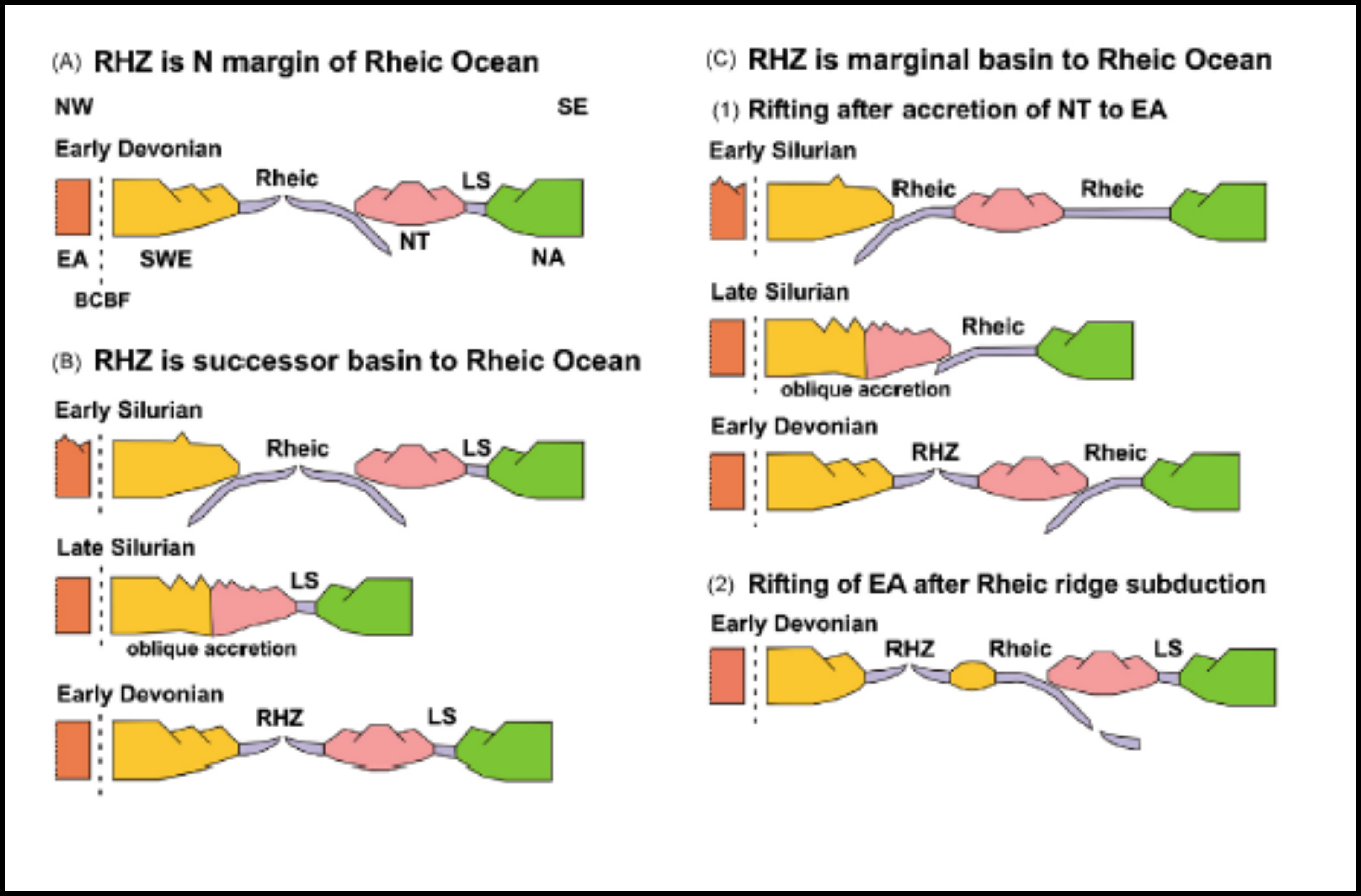Rhenohercynian Tectonic Framework
The Rhenohercynian Tectonic Framework
SW England forms part of the extensional Rhenohercynian passive margin and is located between the Avalonian, Armorican and Normannian microplates. The position of the SW England segment of the Rhenohercynian Zone, its relationship to Rheic Ocean closure and the absence of major deformation caused by the Acadian event is unclear (Holder and Leveridge, 1986; Shail and Leveridge, 2009; Woodcock et al., 2007).
Understanding the pre-Devonian tectonic framework of SW England is hindered by a lack of data to determine the basement of the Devonian passive margin basins (Shail and Leveridge, 2009). Further complications arise due to the overprint of orogenic events from the mid-Silurian onwards relating to Caledonian, Acadian and eventual Variscan collision (Woodcock et al., 2007). Matthews (1984) argued that the Caledonian and Variscan orogenic events are not separate entities but are a single protracted event, going as far as to argue that a Variscan “front” is undefinable. Whilst a Variscan front can be defined structurally through South Wales (Leveridge and Hartley, 2006), therefore indicating a separate orogenic event, Le Gall (1991) suggested that Caledonian structures influenced the formation of E-W trending extensional Devonian basins and are manifest as NW-SE (presumably reactivated) structures during the Variscan Orogeny.
Evidence for a protracted Caledonian-Acadian-Variscan event is lacking in SW England where seafloor spreading in the Lizard Complex (397 $\pm$ 2 Ma; Clark et al., 1998) was coincident with peak Acadian deformation in the Early Devonian (Woodcock et al., 2007). A solution is proposed by Woodcock et al. (2007) that a terrane, termed Prettania (most likely NW Iberia), lay where SW England is now positioned and that the Rhenohercynian Zone lay some 400 km to the southeast. Carboniferous dextral movement along the Bristol Channel-Bray Fault Zone then translated SW England to its current position (Figure 1), but a mechanism for synchronous Acadian deformation and Rhenohercynian extension is yet to be satisfactorily explained (Holder and Leveridge, 1986; Leveridge and Shail, 2011; Woodcock et al., 2007).

The interplay of Avalonia, Armorica, the Normannian microplate (Holder and Leveridge, 1986) and the postulated Prettania terrane (Woodcock et al., 2007) formed a complex pre-Devonian framework upon which the Rhenohercynian Zone formed. The Rhenohercynian may be a microplate in its own right within a large Rheic Ocean which closed in the Silurian with the north-dipping suture buried under the Culm Basin of central Devon (Dijkstra and Hatch, 2018).
Shail and Leveridge (2009) attempt to reconcile the problems discussed above through a series of models illustrated in Figure 2. The Rhenohercynian passive margin is postulated to be not of Rheic origin but a marginal basin prior to, or a successor basin following, Rheic closure. The latter is supported by Dijkstra and Hatch (2018) and from re-interpretation of seismic reflection data by Alexander et al. (2019) who identify two potential south-dipping suture zones along the southern margin. The first, and more northerly, is considered to be a Silurian suture relating to closure of a segment of the Rheic Ocean. The inception of a successor basin resulted in the Rhenohercynian passive margin and small ocean opening prior to a second suture during the Late Devonian.
These proposed model do not account for transtension during opening of the passive margin or formation of oceanic crust. It is possible that transtension was partitioned, resulting in a proximal, transtensional oceanic Gramscatho Basin juxtaposed against the passive margin basins to the north. Seismic and magnetic data infer Carboniferous southward subduction along the Bray segment of the Rhenohercynian suture which may add credence to these models (Averbuch and Piromallo, 2012).

References
Alexander, Andrew C, Robin K Shail, and Brian E Leveridge. 2019. “Late Paleozoic extensional reactivation of the Rheic–Rhenohercynian suture zone in SW England, the English Channel and Western Approaches.” Geological Society, London, Special Publications 470 (January): SP470.19. https://doi.org/10.1144/SP470.19.
Averbuch, O, and C Piromallo. 2012. “Is there a remnant Variscan subducted slab in the mantle beneath the Paris basin? Implications for the late Variscan lithospheric delamination process and the Paris basin formation.” Tectonophysics 558-559 (August). Elsevier B.V.: 70–83. https://doi.org/10.1016/j.tecto.2012.06.032.
Clark, A H, D J Scott, H A Sandeman, A V Bromley, and E Farrar. 1998. “Siegenian generation of the Lizard ophiolite: U-Pb zircon age data for plagiogranite, Porthkerris, Cornwall.” Journal of the Geological Society, London 155: 595–98.
Dijkstra, Arjan H., and Callum Hatch. 2018. “Mapping a hidden terrane boundary in the mantle lithosphere with lamprophyres.” Nature Communications 9 (1). Springer US. https://doi.org/10.1038/s41467-018-06253-7.
Holder, M T, and B E Leveridge. 1986. “Correlation of the Rhenohercynian Variscides.” Journal of the Geological Society, London 143 (1): 141–47. https://doi.org/10.1144/gsjgs.143.1.0141.
Le Gall, B. 1991. “Crustal evolutionary model for the Variscides of Ireland and Wales from SWAT seismic data.” Journal of the Geological Society, London 148: 759–74.
Leveridge, B E, and A J Hartley. 2006. “The Varisan Orogeny: the development and deformation of Devonian/Carboniferous basins in SW England and South Wales.” In The Geology of England and Wales, edited by P J Brenchley and P F Rawson, 2nd ed., 225–56. The Geological Society, London.
Leveridge, B E, and R K Shail. 2011. “The marine Devonian stratigraphy of Great Britain.” Proceedings of the Geologists’ Association 122 (4). The Geologists’ Association.: 540–67. https://doi.org/10.1016/j.pgeola.2011.03.003.
Matthews, S C. 1984. “Northern margins of the Variscides in the North Atlantic region: comments on the tectonic context of the problem.” Geological Society, London, Special Publications 14: 71–85.
Shail, R K, and B E Leveridge. 2009. “The Rhenohercynian passive margin of SW England: Development, inversion and extensional reactivation.” Comptes Rendus Geoscience 341: 140–55.
Woodcock, N H, N J Soper, and R A Strachan. 2007. “A Rheic cause for the Acadian deformation in Europe.” Journal of the Geological Society, London 164: 1023–36.